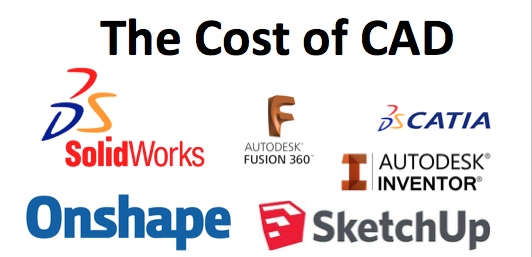Pricing Of Popular CAD Programs: Solidworks Vs. Onshape Vs. Inventor vs. SolidEdge vs. Catia vs. Sketchup vs. Etc!
Designing products is hard but thankfully computers make things easier. Even so the cost of popular computer aided design software is often obscured, making it hard to figure out exactly which tool is right for you.
These days SaaS models and cloud services are starting to creep up on the historical players in the CAD Industry. For any engineers, designers, or business owners who have spent $20,000 on a single license for a piece of software this is potentially good news. Those prices often were justified by the niche nature of the product, again thanks to the proliferation of add-ons and SaaS tools, it is getting tougher to justify those numbers.
To better understand the challenges of these costs we tracked down as much information as we could on some of the leading CAD programs and their current costs structures. You can check the latest Autodesk pricing promotions on Inventor, Fusion 360, 3ds Max, AutoCAD, etc. to see if you can get one of their current deals. We will compare and contrast Autodesk software pricing versus other providers.
First, let’s take a look at Solidworks.
Solidworks
Solidworks recently announced a change in their pricing structures. In the past a license was perpetual, meaning you kept it forever but had to pay a substantial upfront fee of nearly $5000, and updates required a hefty annual maintenance fee of around $1000. Now though it is possible to get term-licenses. For early stage companies, or those looking to utilize the software for a specific project this provides an option to pickup access to the software for 3-6 months.
Not only does this lower the overall cost but it also fundamentally changes how companies can approach purchases from the accounting side. At $6k+ the license is typically a capital expense that can be depreciated over time, while the term license works as a simple expense.
A term license for 3 months and will still set you back around $1000, according to most sources. The difference is subtle but removes much of the complexity of accounting for software and aligns better with the rise of SaaS tools. SOLIDWORKS: Offering Users the Freedom of Choice
Onshape Pricing Vs. Solidworks
Onshape also just announced a change in their pricing structure. In the past the software was had two notable tiers, free and $99/month. The free version included storage of up to 10 private documents while the paid version provided private storage, additional licenses were the same price.
Now the free version is limited to only public documents. While many forum lurkers responded negatively to this it makes sense from a business standpoint. Sure a hobbyist might want to keep their documents private but to what ends?
If you are worried about IP theft then protecting your documents with a paid service makes sense and most contractors and freelancers can justify the Pro version and private documents with the first few hours work.
This also ensures that the marketing efforts of Onshape focus on paying customer and I’m sure their KPIs are easy to track knowing that any private documents are from folks willing to pay. The Pro version also went up by a whopping 20%, though that is still only $120/month. Given that Onshape runs in the browser and requires no special hardware it is still one of the best values for a CAD tool and I anticipate this SaaS structure will help them appeal to small and growing organizations.
With $150+ million in funding Onshape needs to grow their user base in order to be a good investment. Focusing on small organizations and providing an easy on-boarding with such a low monthly fee will help them establish themselves in the new hardware startups. Time will tell if this method works for them but in the mean time early stage companies and hobbyists will benefit from the new strategy.
Inventor vs. Onshape
Inventor is owned by Autodesk who has made a push towards cloud and Saas. Thankfully they publish most of their pricing so it is easy to figure out what the baseline software cost. There are options for $285/month, with discounts for annual buys including $5100 for a 3 year license.
Even though it seems fairly obvious what pricing is Autodesk can be hard to navigate. Their suite of products is a mile long and they provide add-in services for every imaginable feature of need. So for custom organizations that require unique design tools it is likely more complex than paying a monthly fee.
To get a better sense of what the whole suite of products might run you, Ralph Grabowski has a wonderful summary.
SolidEdge vs. Autodesk
Siemens is an absolutely massive company who makes everything from Ultrasound machines to cad software. On the reddit forums the more popular product is Seimens NX, which is a much more robust package. Solid Edge competes in the lower level mechanical CAD market, more similar to Onshape and Fusion, and also is priced nearly the same. Ultimately it is one of the cheapest PRO tools on this list at $75/month.
Fusion 360 Vs. SolidEdge and Onshape
Fusion 360 competes directly with Onshape and Solidedge. Their pricing model is right on par and an annual license can be had for only $300. That is a steal for the ability to design components and output them to prints or files to share with suppliers.
Again here the easy of getting up and running for small organizations make it a great place to start, while being in the Autodesk ecosystem ensures that any future needs will be satisfied by other products. The pricing is also low enough and structured to avoid the high end capital costs which can make accounting a nightmare.
Catia vs.
According to the Reddit forums, which are anything but scientific, Catia is still one of the most popular CAD packages. Given that it is rumored to be well over $20,000 per seat this certainly put it in a different category, and highlights a fundamental shift in strategy.
Catia has significantly more built in functionality that any of the above entry level CAD tools, including OnShape and Fusion. Given that and the cost it falls into a different path to purchase as well, since nearly all organizations making this level acquisition will require a CTO level sign off. That being said for aerospace and defense contractors who need a complete tool that ensures data is secure while being accessible to all members of a team it has it’s place.
If you are considering CATIA then browsing the web for prices is surely the least efficient way to find out the cost. Instead it is worth simply reaching out for a quote since you will have to eventually.
Sketchup
I put Sketchup on here since it is often considered for entry level design. This is in part due to it’s history as a free tool, which allowed a number of students and educational organizations as well as hobbyists to become familiar with the tool. Ultimately Sketchup serves a bit of a different function, and I have yet to hear of any organization using it for mechanical design at a professional level.
With all that said Sketchup is still great as an architectural design tool and way to showcase ideas quickly. The full license is around $700 while students can still pick up a license for “less than the cost of a text book”, or $49.
Cost Comparisons of CAD Tools
This is not a comprehensive list, but it does provide a good sense of what you should expect if you are looking for a single seat for a basic CAD package. No doubt any of these vendors will be happy to expand to multiple licenses and offer a slew of add-ins that can up the cost but those are all project specific.
The good news is that the CAD industry is evolving and introducing the pay-as-you-go model. Despite the mention of Catia, which still costs as much as a car, there are many options to get into CAD software without having to plunk down a huge upfront fee. For freelancers and early stage companies this drastically reduces the investment needed to get up and running with professional tools and ultimately this benefits everyone as more new innovations can be brought on line at a fraction of the cost.

